Shevlin Sebastian's Blog, page 32
December 18, 2019
East-West
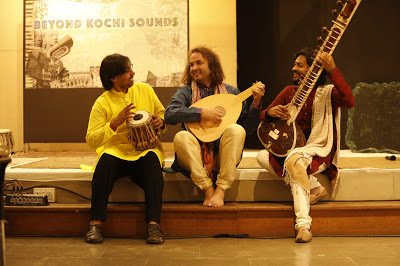
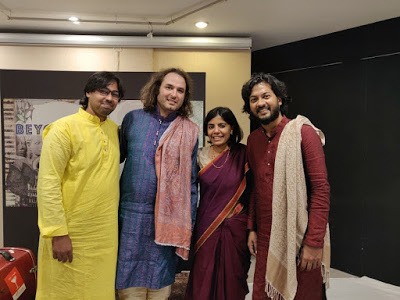
At the Kochi Museum sitarist Rohan Dasgupta, tabla player Arunava Mukherjee and Italian lute player Emilio Bezzi had a unique musical interaction
Pics: (From left) Tabla player Arunava Mukherjee, lute player Emilio Bezzi and sitarist Rohan Dasgupta. Photo by Arun Angela. The trio with Aditi Zacharias, Director, Kerala Museum
By Shevlin Sebastian
It would seem like a typical Indian music concert. On the left is Arunava Mukerjee on the tabla, while on the right is Rohan Dasgupta on the sitar. But the person sitting in the centre indicates that this is a different type of concert. He is a brown-haired musician by the name of Emilio Bezzi and the Italian is playing a modern version of a 500-year-old instrument -- the lute.
And the dance songs, ‘Saltarello’ and ‘Piva’ are also five centuries old. It had been composed by Joan Ambrosio Dalza (about 1508). Rohan and Arunava provide accompaniment. Later, Rohan takes the lead and plays an original composition based on Raga Parameshwari as a tribute to Pandit Ravi Shankar, the genius who put the sitar in the international limelight. The others again provide good accompaniment.
The concert called ‘Beyond Kochi Sounds’ took place at the Kerala Museum recently. “This is a music programme that brings together sounds from across geographical borders and genres,” says Aditi Zacharias, Museum Director.
The collaboration between Rohan, Arunava and Emilio happened by accident. Last year, in February, Rohan had met Emilio at the Italian Institute of Culture at Delhi. To celebrate the 70-year-old relationship between Italy and India, there was an exhibition of the paintings of Raphael (1483-1520). “Somebody said it would be nice to have some Renaissance music,” says Emilio.
As Emilio was thinking about it, the Institute’s Director Andrea Baldi suggested a collaboration with Rohan. When the exhibition moved to Kolkata, Emilio met up with Rohan at a guest house and they played together.
“There was an immediate connection,” says Emilio. “We felt we could create something new. There is something common with classical Indian and Renaissance music. Both are based on modality. And both our instruments are string-based.”
Adds Rohan: “If I say, ‘Let’s play Raga Hemavati or Madhuvanthi’, Emilio can find an equivalent sound. We come from different schools of thought, but Emilio can improvise on the same scale. So we could meet at a unique point.”
What helped was that Emilio is a fan of Indian music. Thanks to his father, a jazz musician, he came across the records of Pandit Ravi Shankar when he was a teenager. “I have listened to these records hundreds of times,” he says. “In 1996 I attended a concert of Ravi Shankar at the Barbican Centre in London. It was one of the best shows that I have attended.”
The first concert of Emilio and Rohan took place at Ljubljana, the capital of Slovenia in December, 2018. “The audience was accustomed to Renaissance music,” says Rohan. “But they liked this collaboration. Most were impressed and they said they liked the sound.”
It was after this concert that Emilio and Rohan felt that something was missing. “We needed a body to the music,” says Rohan. “We felt we should include percussion. But since Emilio likes the sound of the tabla, we decided to get a player. That is how the talented Arunava came in.”
Emilio and Rohan clarify that they are both traditionalists. “We don’t make any sound outside our classical repertoire,” says Rohan. “It is a classical crossover.”
Asked whether the collaboration has changed them, Rohan says, “When you step out of your school of thought, the gainer is you. You get a wider vision. And you grow as a musician.” Emilio and Arunava nod in unison.
Published on December 18, 2019 21:28
Following a different beat
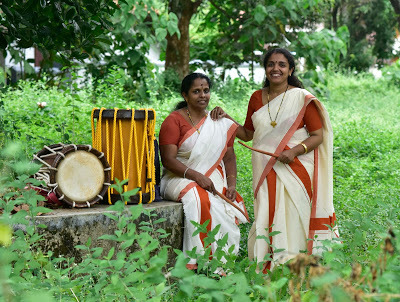
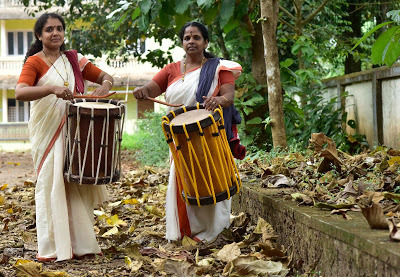
Deepa V and Nalini K are a rarity in Kerala. Both can play the male-dominated chenda. Now they are looking forward to bettering their skills
Pics: Nalini K (left) and Deepa V. Pics by Albin Mathew
By Shevlin Sebastian
It’s 3 a.m. Deepa V wakes up with a start. She takes short breaths. Then she slowly calms down. But she sits up, puts the pillow on her lap and taps it rhythmically.
After 20 minutes, she feels a sense of calm descend on her. Then she lies down and goes to sleep. Deepa has this sense of nervousness and excitement because the next day is her arangettam (public stage debut) for the chenda (a drum-like percussion instrument) at the Thrikkakara Vamanamoorthy temple. Out of 19 debutants, she is the only woman.
The next day, September 1, at 9 p.m., Deepa is standing on the stage, clad in a white saree (settu mundu) and saffron blouse, a black bindi on her forehead, a gold necklace around her neck, gold earrings, and with a bunch of jasmine flowers in her hair. The chenda, which weighs 10 kgs, is being held at waist-level. On either side of her are the male drummers. They are all bare-bodied, and wearing white dhotis. A brass oil lamp, with its wicks all lit, has been placed on the red carpet in front.
Suddenly, in unison, the performers start beating the drums with a reddish-brown wooden stick using the right hand. The palm of the left hand is used to tap on the skin of the drum. The programme has begun. What is taking place is a Panchari melam (a percussion ensemble which only takes place inside a temple).
The other instruments which are being used are the ilathalam (pair of cymbals), kombu (wind instrument) and kuzhal (double-reed wind instrument). There are five stages, and these are based on beats totalling 96, 48, 24, 12 and 6 respectively. But for this programme, the group starts at 24 beats and goes downwards.
One-and-a-half hours hour later, the programme ends. And Deepa’s teacher Bijumon K Marar feels overwhelmed and hugs her. “I felt so happy when my master hugged me,” she says. Her children Govardhan (9 ½) and Govindan (7) also ran up to congratulate her.
But it all began so accidentally for Deepa. She wanted that Govardhan should learn the chenda. So, on most mornings at 7 a.m.., she would bring him to the temple. The boy took to the drums and two year later did his arangettam. But when it came to Govindan, he was not interested. So the teacher suggested that Deepa could also learn and that might encourage the boy to learn.
“So that’s how I started learning the chenda, in November 2018,” says Deepa. “I would practise daily from 7 a.m. to 8.15 p.m. When the daily Pantheeradi Puja began, we would have to stop.”
Initially, she would sit on the floor and hit a granite stone with the wooden stick, made of tamarind. “I did this for about ten months,” says Deepa. But there were many days when Deepa could not be present. One reason was because of her job.
She is an assistant news editor in a Kochi-based English language daily. After her night shift, when she would reach home, it would be 2 a.m. “I could sleep for only four hours,” she says. “Sometimes, I was so tired I could not hear the alarm. So I would miss the classes.”
But in the last month, before the arangetram, Deepa had to pull out all the stops. There were practice sessions from 8 a.m. to 8 p.m. “The first 15 days, I took half-day leave,” says Deepa. Then during the last week before the performance, Deepa was on leave as she began practising on the chenda for the first time.
And today Deepa feels happy. “I feel so confident now,” she says. “I believe that women have a lot of calibre but too many blocks are put up by society. And women also put restrictions on themselves. But through the chenda, I am breaking my mental inhibitions one by one.”
Another woman who has broken her inhibitions is Nalini K. After her husband’s death four years ago, in Kozhikode, she came to Kochi to stay with her daughter Deepthi, who works at Info Park. Every now and then she would go to the Thrikkakara Vamanamoorthy temple. And during the festival season she would gravitate towards the chenda players.
It brought her memories of her childhood. Her home was adjoining the Kothamangalam Vishnu Temple. She would hear the sounds of the chenda. “I would use a stick and hit on the utensils and make a similar sound,” she says.
One day, at the temple, she approached Biju Asan and asked whether she could learn. He said, “Why not?” And that was how in August, 2017, she began going for an hour’s daily practice at 7 a.m.
And slowly, Nalini regained her purpose in life. “It brought me a great deal of happiness,” says Nailini. “I had a lot of health issues. When my sister would call, I would cry. But all my physical ailments and fluctuating moods vanished when I began playing.”
And when she put a video of her drumming in the family WhatsApp group, they gave kudos to her.
Her arangettam took place in August, 2018. “It was the first day of the devastating floods,” she says. “But our show took place.”
She is now moving towards the second level. Deepa also intends to carry on playing. “My goal is to reach the higher levels of the art and play alongside reputed artists,” she says.
And Bijumon is the happiest of the lot. “For centuries, it was only men who played the instrument,” says Bijumon, who has taught more than 500 students for free at the temple for 15 years . “Out of this number, there has been only 15 females. I am so glad Deepa and Nalini have become proficient. It will encourage other women.”
Published on December 18, 2019 02:50
December 16, 2019
Authoritarianism is growing worldwide, says Benyamin, as his novel, ‘Al Arabian Novel Factory’ is released in English
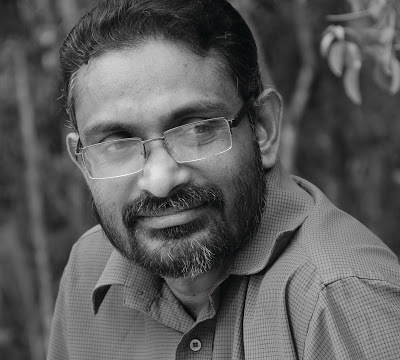
By Shevlin Sebastian
[His Majesty] can’t sleep. If he does sleep, he dreams of being chased through a dirty tunnel. Eventually he is caught, dragged through the tunnel like a rat is dragged out of its hole, punched and violated, and in the end, shot. At this point, he wakes up suddenly and examines his body for bruises. Where did I get shot? Is this blood? Am I in the palace or in the tunnel? He is not able to sleep again. He complains of a heaviness in his chest. Counselling and medication don’t work. What can I say, he is a coward. This is the first time he has seen a protest. I keep telling him you need to practise facing your people. But he has always lived in the palace, surrounded by flattery and luxury.
This is an extract from Benyamin’s ‘Al Arabian Novel Factory’. The English version has been published on December 15 by Juggernaut in a beautiful translation by Shahnaz Habib. This is a sequel to ‘Jasmine Days’, which had won the inaugural JCB Prize for Literature last year. Asked what the second book is all about Benyamin says, “In ‘Jasmine Days’ I focused on the revolution in Arabia. But in the ‘Arabian Novel Factory,’ it is about what happened after that.”
In the story, Pratap leaves his family in Toronto to go to a West Asia city, which is unnamed. He is supposed to do research on behalf of an author. But his secret desire is to meet up with Jasmine, his long-ago love. During his time in the city, he comes across a manuscript which tells the story of the Arab Spring and its failure.
As for the meaning of the title, Benyamin says, “Nowadays when a well-known writer writes a novel, it is not his effort alone. Instead, many people collect data for him. There are others who do the cross-checking. Some do the interviews. So it is similar to a product made in a factory. That’s why I called it a novel factory.”
The book deals with the theme of authoritarianism. “In most countries in West Asia, there is no political freedom,” says Benyamin. “As for freedom of expression, it is non-existent. You learn instinctively how to behave in a repressive society.”
But there are enlightened people who are conscious of their political rights and the need for democracy. “I have met them,” says Benyamin who had lived in Bahrain for twenty years, before returning to Kerala in 2013. “It is a torment for them that they are not able to express themselves. So they migrate to Europe and other countries and start writing about their experiences.”
He admits that India is going down the same path. “We are reaching a situation where people are afraid to talk about what they are thinking,” says Benyamin. “This is being down unconsciously. As [industrialist] Rahul Bajaj said recently, there is a pervasive fear in the country.”
What is most distressing is that people are supporting authoritarianism all over the world. “I feel that they have become so frustrated with politicians and their false promises that they believe a strong leader will provide all the solutions,” he says.
“But history has shown this never happens. A strong leader usually ends up becoming a dictator.”
Asked whether a novel can do anything in the face of authoritarianism, Benyamin says, “A novel can give a warning about what will happen? So, it is like a road sign which says, ‘Danger ahead’.”
(A shorter version was published in The New Indian Express, Kerala editions)
Published on December 16, 2019 21:47
December 15, 2019
When fans do their bit
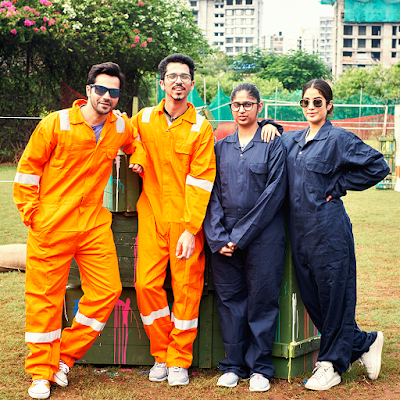

Bollywood actor Arjun Kapoor’s sister Anshula lauds contribution from Kerala and the South for her charity Fankind
Pics: (From left) Varun Dhawan with Amitesh and Asawari Kulkarni and Jahnvi Kapoor; Anshula Kapoor
By Shevlin Sebastian
The Hyderabad-based youngsters, Amitesh, 20, and his sister Asawari Kulkarni, 19, are sitting poolside at the Club, Mumbai on a November afternoon chatting with Anshula, sister of actor Arjun Kapoor and her step-sister, Janhvi. Suddenly, a man comes up behind them, puts his arms around the two and says, “Hello.” They turn around, both gasp, then Amitesh gets up and says, “Hi Varun (Dhawan)” and hugs him.
They sit around and Bollywood star Varun says, “It’s so nice to meet you. When I go for promotional events, it is impossible to have a conversation with the fans.”
Then the siblings give a framed photo of Balaji. Varun looks at it and says, “Thank you so much. We have a small temple in the house and I’ll place it there.” Later they play a game of paintball. And Amitesh says, “I couldn’t remember what Varun was saying. I was so much in shock. This is the first celebrity we were meeting. And also the first time we got on a flight and saw Mumbai.”
So how did the Kulkarnis meet Varun? Through a charity called Fankind run by Anshula. So you log on to the web site (www.fankind.org), and contribute money to a charity favoured by Varun called the Manavlok Foundation which works to help farmers in Maharashtra.
The fans responded. Around Rs 9 lakh was collected over 45 days. And it was used to help set up drip irrigation projects in drought-prone areas. “There is a major water crisis in Maharashtra,” says Varun. “And the worst-affected are the farmers. I am elated to know that we have raised sufficient funds to support Manavlok.”
As for the selection of the winner, the entries are downloaded and put on a website called random.org. “It is like a giant fishbowl and one name is randomly picked,” says Anshula. “It has no bearing on how much money you have donated.”
And Anshula is very happy with the contributions from the South. “We have received good donations from Kerala and Karnataka,” she says. “People from South India are very generous. If they know that their donation is going to genuinely help a child get much-needed heart surgery or a good education, they are willing to donate.”
The celebrities who have been involved so far have been Alia Bhatt, Sonakshi Sinha, Karan Johar and now it is the turn of Ananya Pandey. Thus far, Fankind has collected Rs 14 lakh.
Asked how she got interested in charity, Anshula says, “Whatever kindness I have learned it is due to my mother (Mona Kapoor, who died in 2012). She said, ‘You don’t grow in isolation. You grow along with the community around you’.”
Once there was a stray dog near their house who needed surgery. “Mom said to go out and get the funds for it,” says Anshula. “So, I went to PETA (People For The Ethical Treatment of Animals), took a bunch of calendars and T-shirts and began selling these to families and friends. The money wasn’t enough so my mom put up the rest. But the lesson was that if you want to do something, go ahead and do it. You don’t wait helplessly for somebody to do it for you.”
(The New Indian Express, Hyderabad)
Published on December 15, 2019 21:48
December 11, 2019
A ‘Short’ update
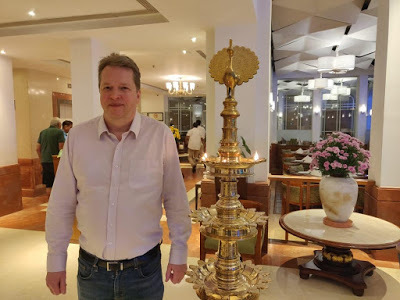
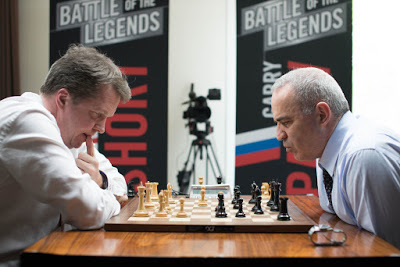
Nigel Short, the former World No 3 in chess, talks about his friend Vishwanathan Anand, and the state of chess in India, while on a recent visit to Kochi
Photos: Nigel Short at the Taj Malabar, Kochi; Nigel Short and Garry Kasparov played in Belgium in 2015. Kasparov won
By Shevlin Sebastian
It is getting dark. Nigel Short is in the Rice Bowl restaurant at the Taj Malabar Resort and Spa, Kochi. Through the glass-paned window, he stares at a few water lilies floating in the backwaters and says, “This is so beautiful.”
Then he looks at a hotel, all lit-up because of the Christmas season, on the opposite bank and says, “Wow, nice.”
He smiles at his guest and says, “I have had a great time in Kerala.” The former World No. 3 had come on a five-day visit to interact with players and officials and to take a coaching session for 50 players. “I was joking with the local chess fraternity that it was good I came to Kerala at the end [after stops in Dhaka, Delhi and Chennai], because if I started here I would not have gone anywhere else,” says Nigel, who has travelled to 129 countries.
He is a close friend of Indian chess legend Vishwanathan Anand. “At one time we were on the same level but then Anand went ahead and became a great champion,” says Nigel. “I like his chess and way of thinking.”
But Anand, who turned fifty on December 11, is suffering from lapses of concentration during matches. “That is par for the course,” says Nigel. “No one can stop Father Time. In longer games, you can play well for the first three hours, but after that, it gets tough, if you are in your forties or beyond. You are unable to concentrate with the same intensity. Most people do not realise that chess can drain you physically.”
It can also give you a psychological blow. When Nigel lost the World Championships final against Garry Kasparov at London in 1993, it took him 19 years to see those matches again. “Once you are defeated it plays on your mind,” he says. “For me, this happened in front of a world audience. You start to get afraid and sometimes these feelings multiply. Fear at the table is very common.”
Asked whether the mind can be trained to withstand fear, Nigel says, “Sure, you can. But in the end, we are all just human beings, not machines. We are influenced by emotions. Kasparov dominated me psychologically. Sitting across him I could feel his intense determination to win.”
Another player who has a similar determination is current world champion Magnus Carlsen of Norway. Like Kasparov, he can also intimidate his opponents because of his relentless wins. As to whether there is any player who could challenge Magnus now, Nigel mentions the name of Ding Liren from China. “He has had the upper hand in blitz chess and is already World No 3,” he says. “You need somebody like Liren who does not get intimidated.”
Meanwhile, on most mornings, in India, when Nigel switched on the sports channels, he only saw cricket, cricket and more cricket. “I thought, ‘Where is chess?’ In the newspapers there is a lot of coverage of chess,” says Nigel. “So, the interest is there, but chess has not reached a wider TV audience. I agree that chess does not have the visual appeal of, say, football or cricket, but there are innovative ways to make the telecast interesting.”
Three years ago, there was a proposal for a chess league, on a similar format as the Indian Premier League. “There was money coming in but this was torpedoed by the All India Chess Federation because they did not have the control,” says Nigel, the Vice President of the World Chess Federation (FIDE). “India is in the top five of chess-playing countries, in terms of talent. So, I have no doubt if you remove the brakes the game will boom.”
(The New Indian Express, Kochi)
Published on December 11, 2019 22:39
December 10, 2019
How to write well
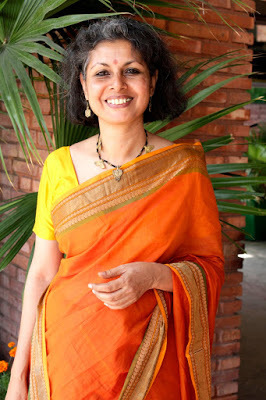
Veteran Mumbai-based editor Suma Varughese, who is holding a workshop in Kochi, talks about the principles and techniques of writing
By Shevlin Sebastian
When veteran editor Suma Varughese saw participant Priya Lakshmi (name changed) at her writer’s workshop in Bangalore last month, she looked lively. However, later, when they spoke a tearful Priya said, “My husband passed away a year ago. He was a wonderful person. I have not been able to get over his death.”
Suma nodded sympathetically.
In the evening, after the workshop concluded, Priya sent a Whatsapp message, “Suma, I want to thank you. I feel alive after such a long time.”
Suma then urged Priya to write about her husband to bring about a closure to the death.
Now Suma is coming to Kochi to hold her workshop, ‘The Zen Of Good Writing’. It will take place on December 14 at the Kochi Business School, from 9.30 a.m. to 5.30 p.m. After the workshop, Suma will continue a month’s instruction on Whatsapp.
Asked about the usual participants in her workshops, Suma says, “It is primarily women. They have a natural bent towards language. Women tend to be more right-brained. Having said that, there are excellent writers from both sexes.”
The participants range in age from 12-75 years. They consist of lawyers, therapists, entrepreneurs, corporates, students and housewives. “There is a widespread longing to write well,” says Suma. “This is a time where everybody has an opportunity to write in the public domain through blogs, Facebook, Whatsapp or Twitter.”
At the workshop, Suma starts with the principles of good writing. “There should be simplicity, brevity and clarity,” she says. “You should show vulnerability, write from the heart and use words of high energy.”
To infuse high energy you should go for dynamic rather than lukewarm words. “Instead of a ‘hot’ day, say it is a ‘torrid’ day,” she says. “Instead of ‘very nice’, use ‘wonderful’. ‘Very’ is a big, fat crutch that we use. Always use the active voice, instead of the passive. In the passive, the sentence construction is awkward and tends to drag.”
She also teaches the participants ways and means to generate ideas. “You can use your own life experiences,” says Suma. “Or when you travel on a bus or train, listen to what people are saying. You will get ideas from their conversations. Your muse will also give you ideas. When the ideas come, you need to write them down. You can develop a habit of looking at your thoughts and asking yourself, ‘Is there an idea there?’”
Right now, Suma says, many people are concerned about the environment. “So a story about the environment will touch many people,” she says.
As for the common errors made by participants, Suma says, “They don’t know how to use the articles ‘the’, ‘a’, and ‘an’. They use it when they don’t need it and don’t use it when it is needed. There is confusion about when to use ‘It’ or ‘It’s’. People have trouble with prepositions and tenses. We shift tenses mid-way through a paragraph. In short, grammar trips up a lot of people. Sadly, the education system is not putting any emphasis on grammar.”
All these drawbacks can be solved through editing. “You can amplify certain sentences, and check the spelling, punctuation and facts,” says Suma. “You have to ask yourself, ‘Am I crisp and clear?’”
Asked for the definition of a well-written copy, Suma says, “It should have a good beginning, an engaging middle and a strong ending.”
(The New Indian Express, Kochi)
Published on December 10, 2019 22:11
December 8, 2019
Foodies everywhere
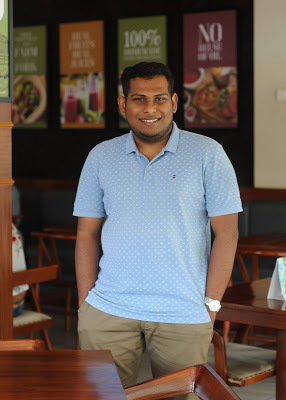
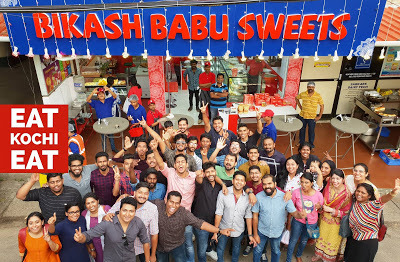
As Kerala’s largest food-loving community Eat Kochi Eat crosses three lakh members, founder Karthik Murali talks about its genesis and flowering
Murali Karthik pic by A Sanesh
By Shevlin Sebastian
One day when Murali Karthik, founder of the food group, Eat Kochi Eat (EKE), put up a post of a dosa on Instagram, chef Gaggan Anand sent a message, ‘I hate you. I am so dosa hungry.’
Murali replied, “Ha Ha come straight to Kochi. Will get you the best dosa and maybe some puttu with mutta (egg) curry also.”
Gaggan sent a laughing emoji. The Thailand-based Gagan had studied at the Institute of Hotel Management and Catering Technology in Kovalam. He was the first Indian chef to be featured on the Netflix show, ‘Chef’s Table’, won a Michelin Two-star and was voted Asia’s No 1 chef in The World’s Best Fifty. “He likes Kerala cuisine a lot,” says Karthik.
Apart from Karthik, many people like Eat Kochi Eat: recently, the group crossed more than three lakh followers on Facebook and Instagram. “It has been very gratifying,” says Karthik, who started the group on September 15, 2015 with a Facebook post.
“I am a foodie and was looking for like-minded people,” he says. And he has attracted a wide range of people. There are college students, couples, career professionals, and elderly people. “When the topic of food comes up, people forgot their differences and have animated discussions,” says Karthik. “I realised there was magic regarding food. We have conducted 35 events in the past four years.”
One such event which took place recently was during Diwali. About 45 people, who paid the registration fee of Rs 100, gathered one afternoon at Bikash Babu Sweets near the Kathrikadavu Railway Overbridge. There is an eating space at the back. “We told the participants they could eat whatever they wanted,” says Karthik. And they did. The bill, for such events, usually comes with a 20 percent discount. But this time, the participants got a surprise. Owner Amit Sarkar gave the savouries for free.
The group has also gone on road trips to Kottayam, Palakkad, Thalassery, Kozhikode and Coimbatore. In Coimbatore, they covered 12 restaurants. “We had two breakfasts, two lunches, and three dinners,” says Karthik, with a smile.
Meanwhile, a lot of material is put online. So, on Facebook, member Shoba Mathew writes about the French Toast with Strawberries. “I cannot even begin to describe how good this tasted,” she said. “The brioche, fluffy and moist, soaked in the strawberry crush, and drenched in a healthy portion of cream, came together to create fireworks in my mouth. This is a dish to be tried once in your lifetime.”
Karthik says a small group vet the posts. “We try to encourage positive reviews,” he says. “But if they are constructive negative reviews, we put that up also. We came to know of people who went to restaurants and said they would put up a negative review in EKE, but would not do so if they got a discount. So we are careful about negative statements. I tell members, ‘Please put up information which is helpful.”
Asked about the future, he says, “Today we are the largest foodie group in Kerala. We want to maintain that position.”
(The New Indian Express, Kochi)
Published on December 08, 2019 23:58
December 6, 2019
How my parents made me a journalist
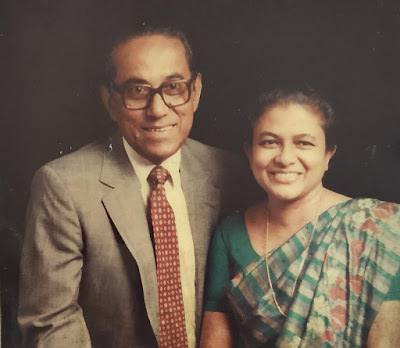

By Shevlin Sebastian
Pics: Parents in their prime; the good old days of the typewriter
Throughout my childhood, my father would bring out a community magazine. So I would see him type up the hand-written articles on his Hermes typewriter. ‘Click Clack’ went the keys at high speed. Then it would be sent to the printers. They would bring the proofs and I would watch as my father made corrections in his clear handwriting using red ink. And then one day the copies would come, in neat bundles, tied with string. I would flip through one and feel amazed at how the hand-written articles had ended up in a neat and compact way inside a magazine.
So, is it any wonder that at age 16, one morning, I borrowed my Dad’s typewriter, rolled in a piece of paper, at a table in the verandah of our ground-floor apartment in Kolkata and wrote my first words? Astonishingly, I went to the end of the page. I read what I had written and liked it. But I knew, from my father’s example, that I needed to edit it. So, I used a pencil to correct and improve the text.
I retyped it and sent it by post to a weekly newspaper which used to come to my house. So imagine my shock and surprise, when two weeks later, the article appeared, without a single word being changed… and I saw my byline in print for the first time. It ignited a passion in me.
My mother also played a role. A few years ago she told me a memory which would be impossible for me to recall. She said that as soon as my father, who was an entrepreneur, left for work, she would sit on an armchair, put me, a few months old, on her lap, and read the newspaper. “I could do that because you always remained quiet and still,” she said.
So I can imagine sitting against my mother, who later became a teacher, listening to her heartbeat and looking at print. Mother and son in a loving meditative silence with the only sound being the rustle of paper, as she turned the pages. Is it any wonder that reading is one of my most cherished habits and I ended up spending my life in the print media.
Nowadays, at 10 p.m. I have a chat with my parents. The conversation revolves around the people we have met, news of relatives, and events in the newspaper. But, always, sometime during the talk, my father will ask, “Is any article of yours appearing tomorrow?” If I say no, he looks disappointed. But I am happy that, after 4500 bylines, my father, who is 93, is still pushing me…
(Published as a middle in The New Indian Express, South Indian editions)
Published on December 06, 2019 22:49
December 5, 2019
Who am I?
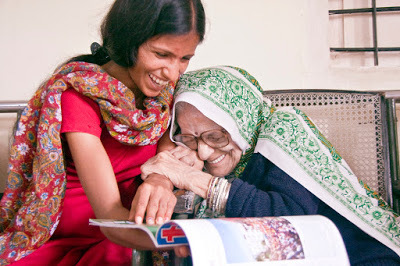
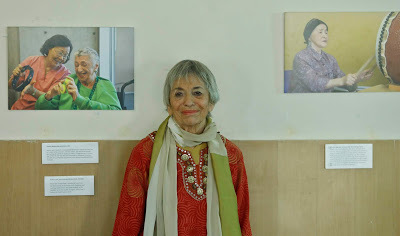
On a recent visit to Kochi, Professor Cathy Greenblat talks about her career about photographing dementia patients and end of life care in Kerala and elsewhere
Pics: Helper Didi with Ashwani. Photo by Cathy Greenblat; Cathy Greenblat. Photo by Arun Angela
By Shevlin Sebastian
When the US-based Professor Cathy Greenblat, noted photographer on ageing, dementia, and end-of-life care, presented her visiting card, there was a surprise. On the back was a photograph of an elderly sari-clad woman who was gripping the elbow of a young woman. Both were smiling widely, but with eyes closed. In front of them was a magazine. It seemed they saw something that was very funny.
“Mother and daughter,” says a visitor, looking at the image.
Cathy smiles and says, “Everybody says that. But no, it is a caregiver, Didi, with a patient, Ashwani who is an advanced stage of Alzheimer's Disease at a day-care centre in Bangalore.”
Cathy says she liked the photo because there is an emotional connection between the two. “It was such a joyous moment,” she says. “Whenever I look at the photo I feel happy. I want to spread this happiness. That is why it is at the back of my card.”
Cathy had come to Kochi as a guest speaker to present a photo exhibition called ‘Arts, Hearts and Minds’ during the three-day international conference on Alzheimer’s Disease, ‘Ubodh’, organised by the Centre for Neuroscience, under the department of biotechnology, CUSAT.
Since 2001, Cathy has been documenting the story of people living with dementia in nine countries -- India, USA, Japan, France, Britain, Dominican Republic, Germany, Monaco and Australia.
And she has met all kinds of interesting people. At the Silverado Senior Living Alzheimer’s community in Escondido, California, she met a woman Hilda who could not remember whether she had lunch or what day it was. “When Hilda, who looked lost all the time, sat down at a piano she could play 400 songs from her memory,” says Cathy. “Music is one of the things that stay the longest in the mind.”
At Silverado, Cathy realised that having Alzheimer's was not a disease that signified it was all over for the patient. “I saw people who were reading newspapers, doing things with flowers, having conversations, sitting at a table and eating with china, glasses and silverware,” says Cathy. “It was so different from what I had experienced in my own life.”
When her grandfather was diagnosed with Alzheimer's he was put into a residential community for people with dementia. There his only activity was to watch TV. “He was a brilliant man who loved to read and talk,” says Cathy. “But they said he could not do anything anymore. This was flawed thinking. Later, my grandmother and mother suffered from the same disease. People have the idea that Alzheimer's takes a big bite out of your brain. But it is more like a mouse nibbling at a big piece of cheese. You lose your capabilities little by little. Our job is to look for what’s there. So I wanted to help change the mind-set, by photographing the best examples of dementia care.”
In Kerala, Cathy spent three weeks taking photographs at the Neighbourhood Network of Palliative Care run by Suresh K Kumar at Kozhikode in 2008 for a project on end of life care. Then she met Dr Jacob Roy, who had founded the Alzheimer's and Related Disorders Society of India. “I went to Kunnamkulam where Jacob had put up first care home for Alzheimer’s patients in Kerala. There were about 10 or 12 residents and I took several pictures,” she says.
Asked whether people react the same across countries, Cathy says, “Yes, they do. They need to feel that they are cared about, that they are not treated as stupid. They want to do things that are meaningful for them. They can go on excursions. In one home, some of the men would be taken to a local pool hall. They liked hitting the balls, drinking a beer and looking at pretty women.”
Earlier, Cathy had a brilliant academic career. She is Professor Emerita of Sociology at Rutgers University, New Jersey, where she served for 35 years. The author of 15 books, she has lectured in the USA, Latin America, Europe, Russia, Africa, the Philippines, China, Australia, and Japan. “But since my retirement, I have been lucky to find another fulfilling career as a photographer,” says the 79-year-old.
(The New Indian Express, Kochi)
Published on December 05, 2019 22:10
December 4, 2019
It’s all about being unique
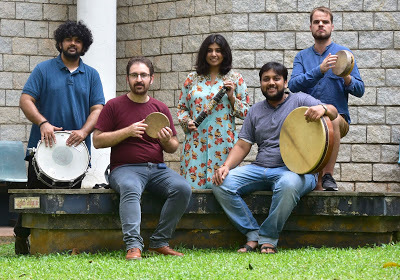
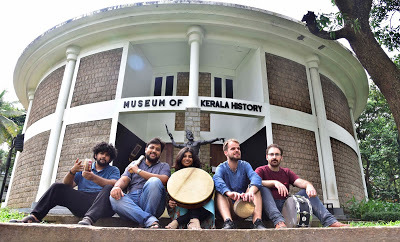
The ‘Sanyog’ music band, comprising Indian, Iranian and Polish musicians enthralled an audience at a concert at Kochi
Pics by Albin Mathew
By Shevlin Sebastian
Very soon into the ‘Beyond Kochi Sounds’ music concert by the ‘Sanyog’ band at the Kerala Museum, on October 12, the audience is soaked in a wide variety of sounds: the violin, saxophone, cajon, drums, tambourine, piano, mridangam, hand cymbals, khanjari and the maraca. This comes as no surprise when you look at the band members: Iranian pianist Hami Keivan, a Polish saxophonist Jerzy Maczynski, violinist Apoorva Krishna (all three of them have just completed their Masters from the Berklee College of Music in Valencia, Spain), and Bengaluru-based Carnatic musicians Vinod Shyam and Sunaad Anoor.
Young Apoorva has been the driving force behind Sanyog. Asked what Sanyog means, she says, “A confluence of world genres, a collaboration, or a coming together.”
The group met for the first time at Bengaluru just three days before their Kochi concert and jammed together for ten hours at a stretch. The majority of the compositions were created by Apoorva, while there were two works by Hami who played the melodies of one of Iran’s notable composers, Abol Hasan Sabā (1902-57), as well as Iranian jazz while Jerzy played Polish jazz, again on two works.
And for Jerzy, it has been a startling introduction to India. During a break in rehearsals, at Bengaluru, he wanted to have black coffee. So Vinod took him, along with Apoorva, on a scooter. And as Apoorva, said with a laugh, “This was the first time Jerzy was seeing a cow, a horse, a few dogs, potholes and too many buses, cars and auto-rickshaws on the road.”
Jerzy nodded and said, ‘Mind-blowing. I didn’t know how to react. But I love Indian culture.”
“And Indian women,” interjected Vinod. At the hotel where they had the coffee, he was taken up by the dusky beauty of the waitress.
Meanwhile, at the Kochi concert, Vinod started singing a konnakol (vocal syllables) ‘Taka Dim, Taka Dim’ and, as the saxophone and violin joined in, it became a hypnotic chant. Many audience members swayed their heads from side to side or tapped their feet.
Yes, the audience lapped it all up. Says Alphons Joseph, Mollywood music director: “Apoorva is a trained Carnatic violinist. Since she went and studied at Berklee, she could bring a wide range of musical genres in her compositions. And she did it so well. I was also very much impressed by the piano-playing of Hami. Thanks to him, I was able to hear a new type of music from Iran. Even Jerzy played very well. All the genres mixed even as they retained their individual identities. It resulted in a new and unique sound, which was very attractive. An analogy would be of different colours being mixed together and a new colour gets formed.”
Guest Captain Suresh said it was an innovative and mellifluous ensemble. “Five very talented musicians who together kept us mesmerised.”
Earlier, during a pre-performance chat, the Carnatic musicians said that it had been a challenging time to get a wavelength with Hami and Jerzy. “Some musicians have said that if you know Carnatic music, you can play any music,” says Vinod. “But that is not true. You have to learn, you have to work.”
Adds Apoorva: “Since I belong to the East and have studied in the West I understood the difficulties for Vinod and Sunaad. The sounds are very different. But then all of us were out of our comfort zones and improvising as we went along.” In fact, one composition at the concert was a jugalbandi that was a marvel in improvisation.
Keeping a paternal eye on the group is Murali Krishna, the father of Apoorva who is also doubling up as the manager of the band. “Innovation is key,” he says. “The sound compositions have never been heard before. The saxophone is combining with the violin and piano. It is a judicious mix of Indian classical, Iranian classical and Polish jazz.”
Murali pauses and says, “This is the music of the future. It will be accepted by the people because cultures are uniting and music is at the forefront of this change.”
Published on December 04, 2019 23:26



